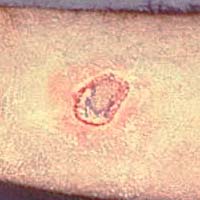A brown recluse spider. Photo Credit: CDC
Spider bites and MRSA share many of the same symptoms, especially in the early stages. As a result, MRSA is often misdiagnosed as a spider bite by doctors.
Most spiders in the U.S. are actually harmless. In fact, most spiders are unable to bite humans at all. The two big exceptions are black widow and brown recluse spiders, both of which are dangerous. Being bitten by a spider can easily go unnoticed. Sometimes the bite of a spider feels like a pin prick. Fortunately, it’s relatively rare to get bitten by spiders, especially the dangerous ones.
A few decades ago MRSA was relatively rare outside hospitals. But in recent years, MRSA has become the most common cause for skin infections seen in the emergency room (N Engl J Med, 2006, Aug 17). And if you’ve been in a hospital recently, the risks of MRSA are many times higher.
So if you think you have a spider bite, but you can’t remember being bitten, there’s a good chance you may have MRSA instead. The pictures below will show you what spider bits look like.
Spider bite pictures and symptoms
The black widow and brown recluse are most common in the Southern U.S. and both like warmer weather. While bites are uncommon, you are most likely to come across these spiders in undisturbed places, such as the back of a closet or garage or in wood pile. Spider bites are hardly ever fatal but are most dangerous in children.
Below are the most common symptoms of these spider bites:
- Pain in the bite area.
- Red and swollen skin around the bit within a few hours.
- Rings or round bull’s-eyes on the skin around the bite.
- Pus filled blisters can sometimes develop.
- Other common spider bite symptoms include: skin rash, fever, nausea, pain and stiffness and feeling fatigued.
What does a spider bite look like? Below are photos of spider bites for comparison to MRSA and Staph infection pictures:

Brown recluse spider bite after 24 hours. Photo courtesy of CDC PHIL (#3163, Harold G. Scott)

Brown recluse spider bite after two months. Photo courtesy of CDC PHIL (#3164, Harold G. Scott)

Brown recluse spider bite after four months. Photo courtesy of CDC PHIL (#3166)

Bite from a Brazilian wolf spider. Photo courtesy of CDC PHIL (#6263, Margaret Parsons)
As you can see in the spider bite pictures above, they look remarkable similar to how MRSA can look on the skin. Because the bite of a spider and a MRSA skin infection can look so similar, even to an expert, a MRSA test is the only way to be certain if you have a MRSA infection or not.

To your best health,
Michelle
Microbiologist and Natural Health Expert
Author of the Natural MRSA and Staph Treatment and Prevention Guidebook MRSA Secrets Revealed





